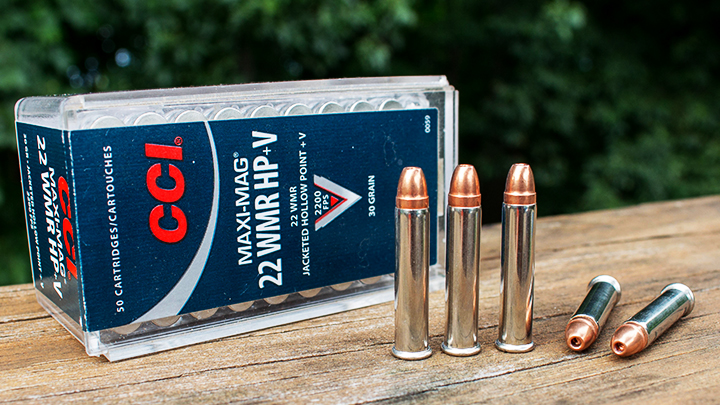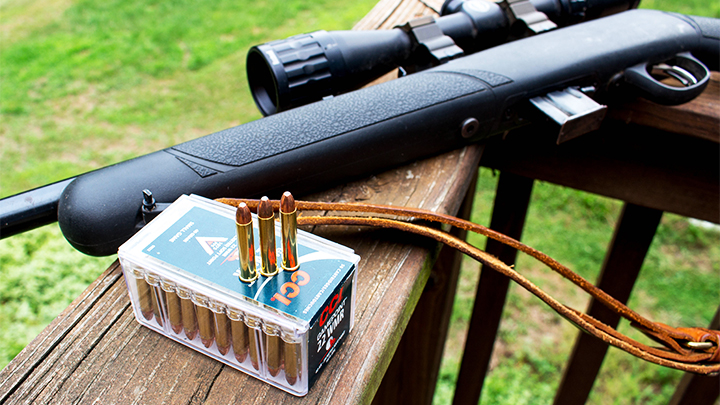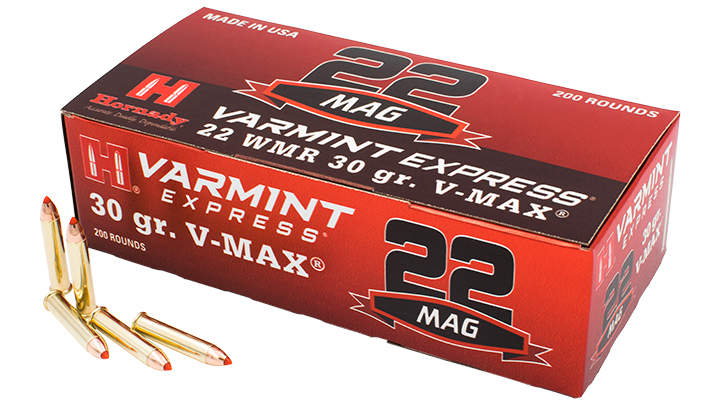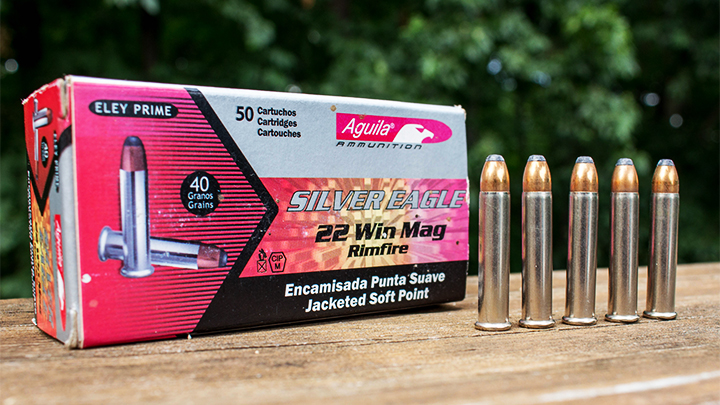
A mere 105 yards from my father’s back door is his vegetable garden and the chicken coop; both attract their fair share of pests and predators, and he is on constant alert, guarding them both fervently. Between the squash-slaying woodchucks, the nest-raiding raccoons and the skunks, foxes and coyotes on the periphery, he spends a considerable amount of time fending off the enemy. The rifle he uses for these defensive missions? A battered (he says well-loved) Marlin bolt gun, chambered in .22 WMR.

“It does exactly what I need it to do, without flattening my eardrums like the centerfires do. It works great out to 125 yards or so.” When my Dad gets hung up on a cartridge, there is no changing his mind, and he has become a devotee of the speedy rimfire cartridge.
Released in 1959, the .22 Winchester Magnum Rimfire—known more commonly as the .22 Mag.—has long been a favorite of those looking to bridge the gap between the .22 Long Rifle and the .22 centerfires. It’s a handy cartridge, capable of taking small game out to 150 yards in the hands of competent rifleman, and is surprisingly accurate. The .22 WMR cartridge is an elongated version of the much older .22 WRF (Winchester Rimfire), which is identical and interchangeable with the .22 Remington Special—the difference between the two being in the shape of the bullet used—and any rifle chambered for the .22 WMR can fire ammo from the two older, shorter cartridges. The WMR cartridge uses a case length of 1.055 inches and an overall length of 1.350 inches, and has a wider case body than the .22 Long Rifle has; it’s not safe to fire a .22 Long Rifle cartridge in a .22 WMR chamber, as the case will be loose in the chamber, and the resultant gasses can injure the shooter.

The .22 Mag. offers a significant velocity increase over the .22 Long Rifle; the former drives a 40-grain bullet at a muzzle velocity of between 1875 and 1910 fps, depending on brand and barrel length, while the latter reaches only 1200 fps. Drop down to the 30-grain bullets and the speeds will jump to the 2200 fps mark. And there are a variety of bullet shapes available in .22 Mag. to take full advantage of that velocity. For example, the CCI Maxi-Mag, using a 40-grain hollowpoint bullet, can be zeroed at 100 yards and will drop only six inches at 150 yards, retaining 114 ft.-lbs. of energy. Compare that to the CCI Velocitor—one of the snappiest .22 LR loads, using a 40-grain bullet at 1435 fps—and you’ll see 9.5 inches of drop, with the bullet retaining only 87 ft.-lbs. at 150 yards. I find the .22 WMR to be a solid performer out to 125 yards on small targets, and I’d have no problem taking to 150 yards on a coyote or fox.
There is a wide selection of ammo available, from the CCI’s Maxi-Mag and GamePoint ammo, to their 30-grain TNT Green lead-free ammo. Federal loads a good number of bullets as well, from the 30-grain Speer TNT hollowpoint to the heavy 50-grain hollowpoint in the BYOB (Bring Your Own Bottle) buck packs. There are sound choices available from Browning, Winchester, Remington, Hornady, Fiocchi, Aguila and others, so there are opportunities for the shooter to experiment and see which brand/bullet weight works best in his or her rifle.

While many loads are developed with the rifle in mind, there are a good number of handguns on the market which use the .22 WMR. My dad—during the height of the fur market in the late 1970s—carried a Ruger Single Six in .22 Long Rifle to dispatch treed raccoons, with a separate cylinder for the .22 WMR and it always shot well. Speer offers their 40-grain Gold Dot bullet at 1050 fps, which is optimized for short-barreled guns, and Hornady loads their 45-grain FTX bullet in their Critical Defense line. CCI makes their Shotshells loaded with No. 12 shot for the .22 WMR, for those who hate snakes as much as I do.
There are plenty of rifles to choose from, in bolt-action, semi-automatic and lever-action and some neat combination guns with a shotgun barrel underneath a .22 WMR barrel. Henry, Savage, CZ-USA, Browning, Marlin and Ruger offer great rifles, and there are numerous handguns still available for the .22 Mag, including that Ruger Single Six that Dad carried and the LCR double-action as well.

The .22 WMR isn’t as affordable as the .22 Long Rifle—with prices running between 20 and 30 cents per round—but if you want to pursue furbearers and varmints at ranges beyond what the .22 LR can normally handle, well, the .22 Mag. is your baby. The recoil and report are minimal, and new shooters can take the cartridge to 100 yards with no problem, seeing impressive accuracy from the little rimfire cartridge. It doesn’t shoot as flat as the .17 HMR or .17 WSM, but it also doesn’t come with the set of issues the .17s have, namely a bore that tends to foul quickly and the need for a special cleaning rod, jags, etc. The .22 WMR has been with us for over 60 years, and isn’t going anywhere anytime soon.
Looking for previous installments of our "Behind the Bullet" series? We've got you covered.
• .458 Winchester Magnum
• .22 Hornet
• .280 Ackley Improved
• .240 Weatherby Magnum
• .458 Lott
• .264 Winchester Magnum
• .348 Winchester
• .33 Nosler
• .260 Remington
• .30-30 Winchester
• .416 Rigby
• .358 Norma Magnum
• .22 LR
• 7mm-08 Remington
• 8mm Remington Magnum
• .338 Federal
• .224 Valkyrie
• .338-06 A-Square
• 9.3x62mm Mauser
• .257 Weatherby Magnum
• .45-70 Government
• .300 H&H Magnum
• .25-06 Remington
• .30-06 Springfield
• 6.5 Creedmoor
• .300 Remington Ultra Magnum
• 7mm Remington Magnum
• .470 Nitro Express
• .280 Remington
• .300 Winchester Magnum
• .270 Winchester
• .222 Remington
• .45 ACP
• .404 Jeffery
• .44 Remington Magnum
• .41 Remington Magnum
• .243 Winchester
• .338 Winchester Magnum
• .357 S&W Magnum
• 6.5-284 Norma
• 8x57 Mauser
• .38 Smith & Wesson Special
• 7x57mm Mauser
• 9 mm Luger
• .35 Whelen
• .454 Casull
• .375 H&H Magnum
• .45 Colt
• .22-250 Remington
• 10mm Auto
• .308 Winchester



































